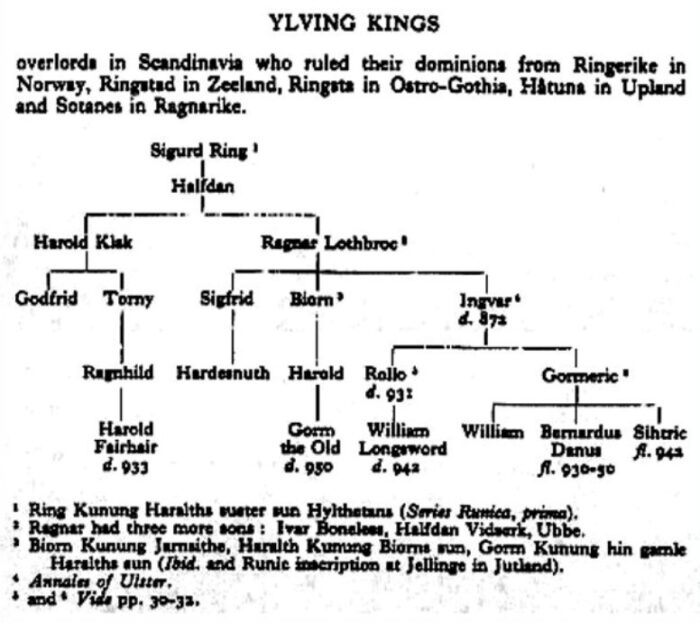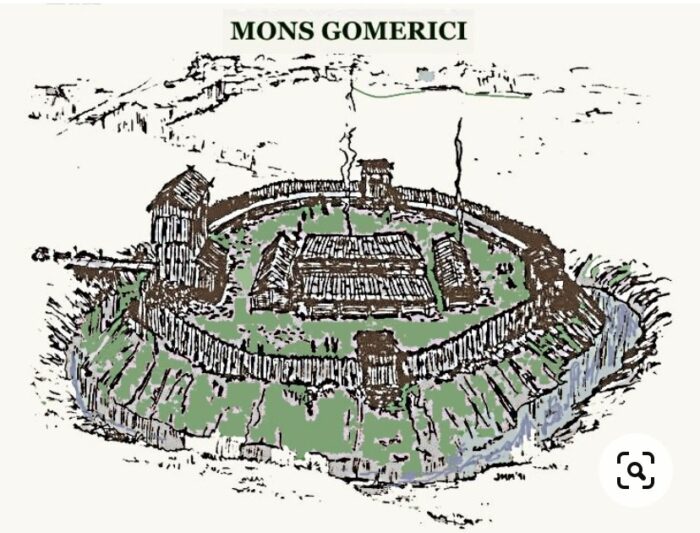Mont Gomeric and the Montgomery name
Or How Gomeric a Viking originated the Montgomery clan
Summarizing and expanding on the previous page:
1. Among the Viking chieftains who ravaged France in the 9th century was Gomeric:
(a) Some historians suggest that Gomeric was the son of Ragnvald Eysteinsson, the Jarl (Earl) of More, a powerful noblemen in Norway who was a close friend of King Harald I.
(b) Alternately, this chart below from “Origins and History of The Montgomerys” by B. G. de Montgomery, suggests that Gomeric was the son of Ingvar Ragnarsson, the Viking King of East Anglia and Northumbria, a kingdom in medieval England.
2. In 876 AD the Viking Rollo conquered Rouen in the France of its day. In 911 AD, Rollo signed the Treaty of Saint-Clair-sur-Epte, a foundational document of the Duchy of Normandy, with King Charles III, in exchange for his loyalty to the king. For his part, Rollo agreed to defend the territory from other Vikings, and that he and his men would convert to Christianity.

3. According to a local source we came across in Normandy, as per what is indicated in the above chart, Gomeric was the brother of the aforementioned Viking chieftain Rollo, although many historians seem to dispute they were brothers. In any case, Gomeric and Rollo were at the least contemporaries.
Probably in the early 900’s, Gomeric settled in the Calvados area of Normandy and fortified a hill —which became known as Mount Gomeric, or Mont Gommeri, as well as Mons Gomerici— which gave the Montgomery family its surname. And as far as Gomeric’s origin, the majority of historians opt that the Montgomery family origins was indeed Scandinavian, as confirmed by Luc De Boever, who wrote “The Montgommerys from the Vikings to our Present Day“.
4. Gomeric may have also been called Robert. In “The Montgommerys from the Vikings to our Present Day“, De Boever writes: “The first chief who carries the Montgommery name … from the place Mons Gomeri … seems to be a certain Robert, contemporary of chief Viking Rollo. …” De Boever also equates Robert as being the grandfather of Roger I de Montgommery, which likewise fits Gomeric‘s profile. [pages 17 and 59]
Further on Robert‘s background, De Boever then goes on to quote another historian:
“Gerard Louise in ‘La Seigneurie de Belleme, Le Pays-Bas-Normand‘ writes, ‘The origins of the Montgommerys are very difficult to place as they rely on the traditions or the late legends related in the XII century. It is certainly a lineage with Scandinavian roots, as the most famous of them, Robert II [i.e. the eldest son of Roger II de Montgommery] declares himself ex Nothmannis Northmannus (Norman amongst Normans.)’ ”
So in converting to Christianity in Normandy, it is possible that Gomeric took a new “Christian name”, Robert; as De Boever elsewhere speculates that the builder of the Mons Gomeri fortress could have been Robert (i.e. Gomeric).

5. While Viking raids into England were first documented as early as the 790s, the Anglo-Saxon Chronicle records that the Vikings (a “great heathen army”) arrived enforce in 865 and conquered East Anglia (in 869–70), Mercia (in 873–74) and Northumbria (in 874–75). The Vikings then started to settle Northumbria (876), part of Mercia (877) and East Anglia (879–80). They also raided deep into Wessex, but in May 878 Viking forces were defeated by King Alfred the Great (who reigned 871–899) at the Battle of Edington in Wiltshire. The defeated army eventually settled in East Anglia.)
6. In 1064, William Duke of Normandy received confirmation that the King of England, Edward the Confessor, had designated him as his heir to the throne. (Edward was the son of Æthelred and Emma of Normandy; William therefore being King Edward’s nephew.) However, when the old King Edward died, Harold (the brother-in-law of Edward) crowned himself King! Hearing this news, William decided to prepare a fleet of ships and cross the English Channel to claim his throne. His ships (somewhere between 1000-1500 in total!) landed and the Norman army made its way towards Hastings, where they took up their positions. On 14 October 1066, the decisive battle between Norman and Anglo-Saxon troops began, ending with Harold being hit in the eye by an arrow and dying in battle. And William Duke of Normandy, now William the Conqueror, became England’s third King of 1066!
7. After the 1066 AD Norman Conquest of England, Gomeric‘s descendant Roger de Montgomery (an ally of and counselor to William the Conqueror) was rewarded with British titles and wealth. (History records that Roger did not actively participate in the 1066 Battle of Hastings as he had been commissioned by William, the Duke of Normandy, to assist Duchess Matilda in governing the Duchy of Normandy.)
8. About 1160 AD, Robert Montgomery (a great-grandson of the above-mentioned Roger de Montgomery, his grandfather being Roger’s son Arnoulf) became the first of the family in Scotland, who along with two younger brothers, went north with Walter Fitzalan, the first High Steward of Scotland, in the reign of David I. In 1165, Robert de Montgomery received a grant of the manor of Eaglesham in Renfrewshire, Scotland (that is, west of Glasgow), which his descendants owned for seven centuries. And Robert Montgomery became 1st Laird of Eaglesham.
9. Following are further historical highlights of the Scottish Montgomery Clan, courtesy of Wikipedia and other sources:
14th Century & Anglo-Scottish border conflicts
A descendant of Robert was Sir John Montgomery who led the Clan Montgomery at the Battle of Otterburn in 1388 where the English were defeated. He was one of the heroes of the day as he distinguished himself by capturing Sir Henry Percy who was known as “the Hotspur”. The Percy family paid a great ransom for the release of Henry “Hotspur” Percy and this money enabled the Clan Montgomery to build the Polnoon Castle.
15th & 16th Century Clan Conflicts
In 1488 the Clan Montgomery burned down the Clan Cunningham’s Kerelaw Castle. The two clans had been on opposing sides at the Battle of Sauchieburn, with Hugh Montgomery among the victorious rebels and Alexander Cunningham, the 1st Earl of Glencairn slain with the defeated James III. A longstanding rivalry (principally over the Bailieship of Cunninghame) was now a vendetta.
During the 16th century the long-running feud continued. Edward Cunningham of Auchenharvie was slain in 1526 and Archibald Cunningham of Waterstoun in 1528; Eglinton Castle (southwest of Glasgow) was burned down by the Cunninghams in the same year.
The government of King James VI of Scotland eventually managed to make the chiefs of the two clans shake hands. In 1661 Lord High Chancellor William Cunningham, 9th Earl of Glencairn, married Margaret Montgomery, daughter of Alexander, 6th Earl of Eglinton, drawing a line under the feud.
Sir Hugh Montgomery, 1st Viscount Montgomery of the Great Ards (c. 1560 –1636) was an aristocrat and a soldier, known as one of the “founding fathers” of the Ulster-Scots along with Sir James Hamilton. Montgomery was born in Ayrshire at Broadstone Castle, near Beith, Scotland, the son of Adam Montgomery, the 5th Laird of Braidstane, and his wife Margaret Montgomery of Hessilhead.
Sir Hugh Montgomery’s friendship with King James (the same King James who commissioned and published the King James Version of the Bible) proved useful in establishing a Settlement in Ireland in 1606 (preceding the Plantation of Ulster in 1610).
17th Century & Civil War
The 3rd Earl of Eglinton led the Clan Montgomery in support of Mary, Queen of Scots, at the Battle of Langside in 1568, where the Queen was defeated. The Earl was declared guilty of treason and imprisoned in Doune Castle. When the Earl was released, he tried to secure the safety and toleration of Catholics in the wake of the Reformation. Ironically his daughter Lady Margaret married Robert Seton of the Clan Seton, the 1st Earl of Winton who was a loyal Covenanter during the Civil War. Their son, Alexander Seton took his mother’s maiden name of Montgomery and became the 6th Earl of Eglinton. He was a Protestant supporter of King Charles II. He was imprisoned by General Monck for his Royalist sympathies in 1659.
Another branch of the Scottish Montgomeries settled in Donegal in Ireland in 1628 and Viscount Montgomery of Alamein came from this line.
At the Battle of Worcester in 1651 much of the Royalist army was under the command of Major General Montgomery who was wounded in the action.
18th Century & Jacobite Uprisings
During the Jacobite Uprisings, Clan Montgomery led by the 9th Earl of Eglington, Alexander Seton Montgomerie, supported the British government. Alexander was also on the Privy Council of King William and Queen Anne of the United Kingdom. In 1715 during the first Jacobite rebellion, the chief of Clan Montgomery was involved in training soldiers for the government, while also rumored to have been a Jacobite sympathizer.
Colonial Wars in North America
Many Montgomery’s had left Scotland for what is now Northern Ireland during the “Plantation” of the 1600s. There they grew, but few prospered. Between 1700 and 1850, driven by economics and politics, many Montgomery’s flocked to the New World.
The 11th Earl and chief of Clan Montgomery raised the British 77th Foot Highlanders Regiment from members of the clan. The 77th Regiment was one of the first three Highland Regiments to fight in North America during the Seven Years’ War (1754-1763) between France and Great Britain. Their exploits in the campaign against the French are legend.
General Richard Montgomery, who first went to America in 1757, was killed in the storming of Quebec on December 31, 1775. He was the first general to die in the American Revolution. Many of the “Montgomery” place names, as well as Counties, which dot the United States honor his memory.
Until the Irish famine years of the late 1840s, Irish immigrants to the New World were majority Protestant; after the Irish famine, far more Catholics than Protestants arrived in the United States. And in Canada, by 1867, Irish were the second largest ethnic group (after the French), and comprised 24% of Canada’s population.
World War II
Perhaps the most famous of all Montgomery’s was Field Marshal Bernard Montgomery, 1st Viscount Montgomery of Alamein. Often referred to as “Monty”, he came from the direct line of Scottish Montgomery’s who settled in Ireland in 1628. Monty successfully commanded Allied forces at the Battle of El Alamein, a major battle in World War II, and troops under his command were largely responsible for the expulsion of Axis forces from North Africa. He was later a senior commander in Italy and North-West Europe, where he was in command of all Allied ground forces during Operation Overlord, codename for the Battle of Normandy.
So from Normandie to Normandy, full circle!
Gomeric the Originator, to Monty the Liberator!
